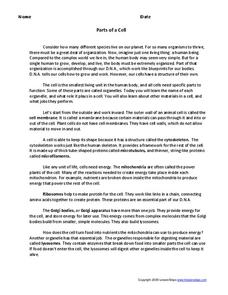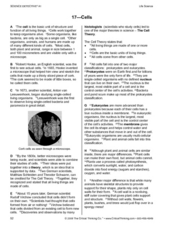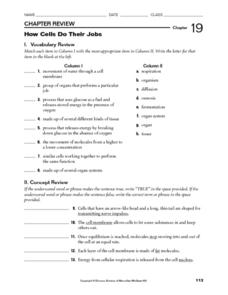Curated OER
Human Cheek Cell
Get up close and personal with human cells with this lab worksheet. Learners use a microscope to examine their own cheek cells, drawing diagrams of the cells and identifying the parts when they have focused in on a visible specimen....
Curated OER
Parts of a Cell
Simplify the parts of a cell with this handout and brief activity. Learners read a two-page explanation of the parts of a cell that includes bolded vocabulary words. Using what they have just read, class members answer 19...
American Museum of Natural History
Differentiate! The Stem Cell Card Game
Let the games grow. Groups play a card game to grow cells. Players start growing cells from stem cells to create specialized cells in the human body. Learners use full-grown cells from the human body to create stem cells in the lab to...
Curated OER
The Great Animal Systems Challenge!
Advanced placement biology aces list systems that have evolved over time, adaptations, and structure-function relationships. The resource requires plenty of writing to answer these questions, so allow a few days for them to complete the...
Curated OER
Extracting DNA from Your Cells
Three steps are needed to extract DNA from learners' inner cheek cells. The procedure and reasons for each step are explained. As enzymes work on the cells, a series of questions are answered regarding the structure of the DNA molecule....
Biology Junction
Cellular Division
Based on current scientific knowledge, all cells come from preexisting cells. Scholars learn about cell division, cell replication, mitosis, meiosis, and more with a PowerPoint. It describes the differences between prokaryotes and...
Curated OER
How HIV Infects Cells
In this how HIV infects cells activity, students read the given information about how HIV infects cells. Students explain the role of various structures in HIV infection. Students design a drug that might slow the rate of cellular...
Curated OER
Human Excretion: Living Environment
A solid review of the excretion system that presents diagrams and asks learners to name the labelled parts or to identify which parts perform the particular jobs stated.
Curated OER
Structure and Function of the Cell/Introduction to the Cell
So, this is not technically a worksheet, but rather a chapter of reading material, pictures, and diagrams introducing young biologists to the cell. Cell theory, diversity, size, and shape are described. The internal organization and...
K12 Reader
Tissues, Organs and Systems
Young scientists are introduced to the connections among cells, tissues, organs, and systems in a life science reading comprehension worksheet that asks them to respond to a series of questions based on the passage.
Curated OER
17 - Cells
The first of three pages in this handout provides a brief history of our understanding of the cell. It also differentiates between prokaryotic and eukaryotic cells. The second is a collection of true and false, multiple choice, and short...
Curated OER
The Immune System
Activate the immune system in the brains of your biologists! This worksheet calls upon learners to explain the structure, function, and problems associated with the immune system. This worksheet is helpful for the advanced placement...
Curated OER
Observing Specialized Cells
For this plant and animal cell worksheet, students draw five examples of plant or animal cells that are specialized to perform a particular functions. They also complete 6 short answer questions based on their observations.
Curated OER
Cell Cycle
In this cell cycle learning exercise, 7th graders study the various images of the cell cycle. Students then label each picture with the correct cycle. Students then answer several questions about the cell cycle.
Curated OER
Bones: Reading and Quiz
Make no bones about it- this anatomy worksheet is all about the human skeleton! Learners read a 2-page informational excerpt on bones and then use the information they learned to answer 9 recall questions, including 4 multiple-choice and...
Curated OER
How HIV Infects Cells
In this biology learning exercise, students answer 2 short answer questions related to HIV based on information provided. They color and label the different parts of a virus.
Curated OER
The Nervous System: Basic Organization and Function
A vintage worksheet on the basic structure and function of the nervous system awaits your beginning biologists. Although it pertains to a textbook chapter reading, the content is relevant to any introductory unit on the nervous system....
Curated OER
Diffusion across a Selectively Permeable Membrane
Lab groups fill a section of dialysis tubing with glucose and starch solutions and suspend it in a water bath. They use iodine as a starch indicator and a glucose test strip to find out if either of the materials crossed the selectively...
Curated OER
The Human Body
In this human body activity, students will review the characteristics of the body systems: skeletal, circulatory, muscular, digestive, urinary, endocrine, reproductive, lymphatic, and respiratory systems. This activity has 12 fill in the...
Curated OER
How Cells Do Their Jobs
In this cells learning exercise, students will review cell characteristics and structure and different types of cells and what role they play in the body. Students will investigate experimental results of the influence of sucrose on the...
BC Open Textbooks
Concepts of Biology – 1st Canadian Edition
How diverse are living things? Individuals explore topics such as cells as the foundation for life, cell division and genetics, molecular biology, and animal reproduction using an open resource Biology textbook. They learn key terms...
Federal Reserve Bank
Why Scarce Resources Are Sometimes Unemployed
Why do markets operate inefficiently when the world's resources are so limited? Review the various types of unemployment that exist and why some resources, especially human resources, go unused.
Rice University
Biology for AP® Courses
An eight-unit electronic textbook provides a guide to AP® Biology. Each of the 28 chapters include an introduction, multiple lessons, a summary, review questions, and test prep questions. Teachers see how each lesson connects to a big...
Curated OER
Viruses
In this virus worksheet, 9th graders study the graph shown that illustrates the sizes of viruses, bacteria, and other structures. Then they state how large a red blood cell is and how large the smallest viruses are that affect plants....























